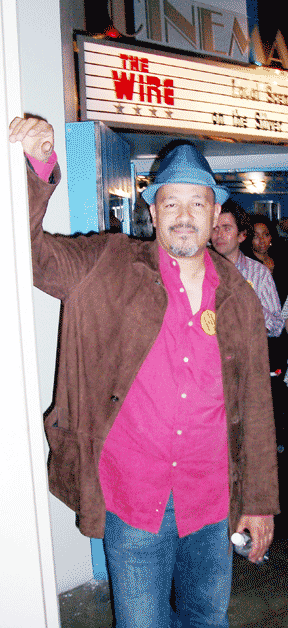|
|||||||||
The Wire TapAfter five seasons on HBO, Baltimore’s best show finds a new homeby Diana Beechener, Bay Weekly staff writer
The shirt Russell ‘Stringer’ Bell was killed in hangs encased in glass at the Baltimore Museum of Industry. As people approach the bloody, bullet-ridden relic, their voices lower in awe. The blood is fake, but the reverence is real. Two months after The Wire rolled its closing credits for the last time, diehard fans still long for their weekly fix. In Maryland, this devotion springs from series creator David Simon’s heart-rending portrayal of city life in Baltimore. Unquestionably the main character — the city, slowly rotting under the weight of corruption and poverty — is the show’s only constant. Its drug dealers, junkies, dock workers, newsies and cops flow in and out of the series like harbor tides. Now the Museum of Industry has opened Local Scenes on the Silver Screen: Featuring The Wire, a two-room tribute to the television show’s contribution to Maryland’s burgeoning film industry. Scenes on the Silver Screen is atypical for a museum known for its interactive exhibits on Baltimore’s cannery industry and meticulous histories of locally born companies such as Black and Decker and Martin Marietta. “The producers of the show and the staff here at the museum wanted to create an exhibit that talked about what people here do in the [film] industry,” says the museum’s curator, Shawn Gladden. “We focus on the behind the scenes.” The exhibit features a marquee theater, the police commissioner’s office set, costumes and props. Styled similarly to Baltimore’s Senator Theater, the blue screening room is bordered by cutouts of the city skyline. Marquee posters of every season adorn the walls along with headshots of The Wire’s main cast and crew. But on the screen are the people seldom seen, the Baltimoreans who worked on the set. Four documentaries, three shot by HBO and one by Villa Julie college students, explore the impact of The Wire on the culture and economy of Baltimore. The second room, housing a recreation of the office of Commissioner Burrell (Frankie Faison) takes you further behind the scenes. You can sit at the stately desk and perform a scene for an on-looking camera while family and friends critique you from a live-feed director’s monitor. You learn the secrets of the hair, makeup and prop crews at small, scattered displays. Pieces of set lie in different stages of construction, demonstrating how plaster and paint can turn plywood into a marble set wall. Photos show the transformation of Aidan Gillen’s wooly hair into the slicked-back style of Mayor Thomas Carcetti. Candid photos take you behind the scenes with cast and crew. Before the unveiling, fans crowded into the Decker Gallery for a panel discussion featuring select members of The Wire’s cast and crew. The panel — actors Clark Johnson and Chad Coleman, executive producer Nina Noble and writer-actor William Zorzi — spoke to the significance of The Wire. “What other show represents a city in that multi-faceted way? Dallas? CSI Miami?” asked Johnson, who played Baltimore Sun editor Augustus Haynes and directed four episodes. Talk focused on series creator Simon’s portrayal of Baltimore’s corrupt authority and incompetence in the war on drugs, the docks, the public schools and the media. This warts-and-all portrait of Baltimore had drawn criticism from a few Baltimoreans and then-mayor Martin O’Malley, but producer Nina Noble cited a higher purpose. Noble argued that critics confuse realism with negativity, because The Wire introduces “people you’d rather not think about and a lot you don’t want to see.” Fans at the discussion didn’t seem to mind Simon’s version of Baltimore. “Thank you. It was a nice hour when we could forget everything else in our lives,” a fan told the panel. Johnson also spoke on Simon’s new venture, which caused a bit of grumbling: His Blown Deadline company trades the stoops of Baltimore for the flooded streets of post-Katrina New Orleans. This stings local fans, who hoped Simon’s uncanny ability to capture Baltimore — as he did in Homicide: Life on the Streets, The Corner and The Wire — would lead to another hometown project. After all, The Wire’s ending montage — of the best and worst of Charm City — demonstrated that even though the cast may change and the cameras might stop rolling, city life continues. “We were just talking about Baltimore,” said Johnson, “till we stopped talking about it.” Simon and the crew of The Wire may have said their piece, but loyal fans want to talk on. For those who bow their heads at Stringer Bell’s bloody shirt or cherish memories of cop Jimmy McNulty and robber Omar Little, Scenes from the Silver Screen keeps the conversation alive. Thru Dec. 30. 10am-4pm Tu-Sa; 11am-4pm Su @ Baltimore Museum of Industry, 1415 Key Hwy., Baltimore. $10 w/discounts: 410-727-4808. |
|||||||||
|
|||||||||
|
|
|||||||||
|
© COPYRIGHT 2008 by New Bay Enterprises, Inc. All rights reserved. |
|||||||||
 Volume 16, Issue 19 - May 8 - May 14, 2008
Volume 16, Issue 19 - May 8 - May 14, 2008

